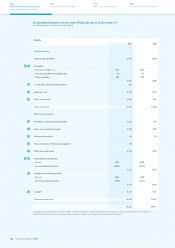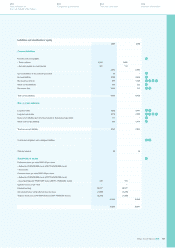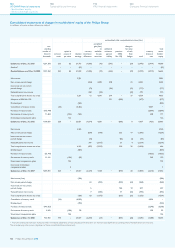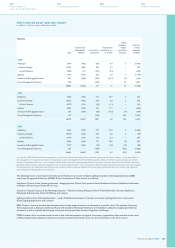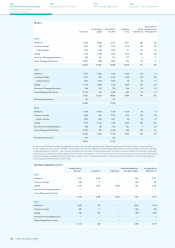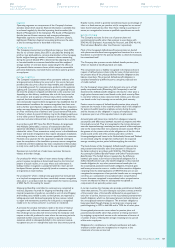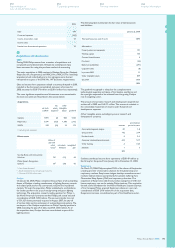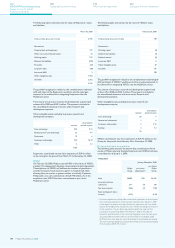Philips 2008 Annual Report Download - page 136
Download and view the complete annual report
Please find page 136 of the 2008 Philips annual report below. You can navigate through the pages in the report by either clicking on the pages listed below, or by using the keyword search tool below to find specific information within the annual report.
Significant accounting policies
The consolidated financial statements are prepared in accordance
with generally accepted accounting principles in the United States
(US GAAP). Historical cost is used as the measurement basis unless
otherwise indicated.
Consolidation principles
The consolidated financial statements include the accounts of
Koninklijke Philips Electronics N.V. (‘the Company’) and all entities
in which a direct or indirect controlling interest exists through voting
rights or qualifying variable interests. All intercompany balances
and transactions have been eliminated in the consolidated financial
statements. Net income is reduced by the portion of the earnings of
subsidiaries applicable to minority interests. The minority interests
are disclosed separately in the consolidated statements of income
and in the consolidated balance sheets. Unrealized losses are eliminated
in the same way as unrealized gains, but only to the extent that there
is no evidence of impairment.
Foreign currencies
The consolidated financial statements are presented in euros, which
is the Company’s functional currency and presentation currency. The
financial statements of entities that use a functional currency other
than the euro, are translated into euros. Assets and liabilities are
translated using the exchange rates on the respective balance sheet
dates. Items in the income statement and cash flow statement are
translated into euros using the average rates of exchange for the
periods involved. The resulting translation adjustments are recorded
as a separate component of other comprehensive income (loss)
within stockholders’ equity. Cumulative translation adjustments are
recognized as income or expense upon partial or complete disposal
or substantially complete liquidation of a foreign entity.
The functional currency of foreign entities is generally the local
currency, unless the primary economic environment requires the use
of another currency. When foreign entities conduct their business
in economies considered to be highly inflationary, they record
transactions in the Company’s reporting currency (the euro) instead
of their local currency.
Gains and losses arising from the translation or settlement of foreign-
currency-denominated monetary assets and liabilities into the
functional currency are recognized in income in the period in which
they arise. However, currency differences on intercompany loans
that have the nature of a permanent investment are accounted for
as translation differences as a separate component of other
comprehensive income (loss) within stockholders’ equity.
Use of estimates
The preparation of financial statements requires management to
make estimates and assumptions that affect amounts reported in the
consolidated financial statements in order to conform to generally
accepted accounting principles. These estimates and assumptions
affect the reported amounts of assets and liabilities, the disclosure
of contingent liabilities at the date of the consolidated financial
statements, and the reported amounts of revenues and expenses
during the reporting period. We evaluate these estimates and
judgments on an ongoing basis and base our estimates on experience,
current and expected future conditions, third-party evaluations and
various other assumptions that we believe are reasonable under the
circumstances. The results of these estimates form the basis for making
judgments about the carrying values of assets and liabilities as well as
identifying and assessing the accounting treatment with respect to
commitments and contingencies. Actual results could differ materially
from those estimates. Assumptions used are further explained in the
related notes.
Estimates significantly impact goodwill and intangibles acquired, tax
on activities disposed, impairments, financial instruments, liabilities
from employee benefit plans, various provisions including tax and
other contingencies such as asbestos product liability. The fair values
of acquired identifiable intangibles are based on an assessment of
future cash flows. Impairment analyses of goodwill and indefinite-lived
intangible assets are performed annually and whenever a triggering
event has occurred, in order to determine whether the carrying value
exceeds the recoverable amount. These calculations are based on
estimates of future cash flows.
The estimated fair value of financial instruments that are not traded
in an active market is determined using observable inputs such as
quoted prices for similar assets and liabilities in active markets; quoted
prices for identical or similar instruments in the markets that are not
active and model-derived valuations whose inputs are observable
or whose significant value drivers are observable. The estimated fair
value of financial instruments that do not have observable inputs or
are supported by little or no market activity is determined using
valuation techniques. The Company uses its judgment to select a
variety of methods including the discounted cash flow method and
option valuation models and make assumptions that are mainly based
on market conditions existing at each balance sheet date.
Actuarial assumptions are established to anticipate future events
and are used in calculating pension and other postretirement benefit
expense and liability. These factors include assumptions with respect
to interest rates, expected investment returns on plan assets, rates of
increase in health care costs, rates of future compensation increases,
turnover rates, and life expectancy.
Accounting changes
The Company applies the retrospective method for reporting a
change in accounting principle in the absence of explicit transition
requirements for new accounting pronouncements.
Reclassifications and revisions
Certain items previously reported under specific financial statement
captions have been reclassified to conform to the current year
presentation.
Prior-period amounts have been revised to adjust for certain
intercompany profit eliminations on inventories in Healthcare related
to prior years. These adjustments are not material to the consolidated
financial statements in any of the prior periods. The table below
outlines the impact of these adjustments:
in millions of euros unless otherwise stated 2006 2007
Decrease in income before taxes (3) (11)
Decrease in income tax expense 1 3
Decrease in net income (2) (8)
Decrease in net income per common share
in euros
- basic (0.00) (0.01)
- diluted (0.00) (0.01)
The effect on retained earnings as of December 31, 2005 is a
decrease of EUR 32 million.
Discontinued operations and non-current assets held for sale
The Company has determined that the level of a reporting unit is
the component for which operations and cash flows can be clearly
distinguished from the rest of the Company and qualifies as a
discontinued operation in the event of disposal of the component.
A component of Philips qualified as a reporting unit is usually one
level below the Sector level. Any gain or loss from disposal of a
reporting unit, together with the results of these operations until the
date of disposal, is reported separately as discontinued operations.
The financial information of a discontinued reporting unit is excluded
from the respective captions in the consolidated financial statements
and related notes and is reported separately.
Cash flow statements
Cash flow statements have been prepared using the indirect method.
Cash flows in foreign currencies have been translated into euros using
the average rates of exchange for the periods involved.
Cash flows from derivative instruments that are accounted for as fair
value hedges or cash flow hedges are classified in the same category
as the cash flows from the hedged items. Cash flows from other
derivative instruments are classified consistent with the nature of
the instrument.
Philips Annual Report 2008136
180
Sustainability performance
192
IFRS financial statements
244
Company financial statements
124
US GAAP financial statements
Significant accounting policies




